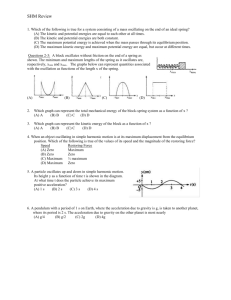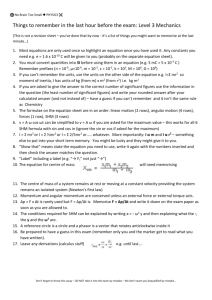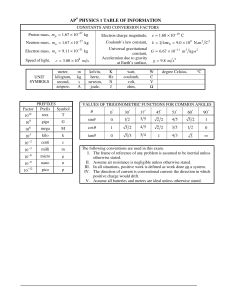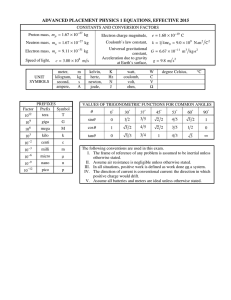PHYS 1111 Exam 2 Formula Sheet
advertisement
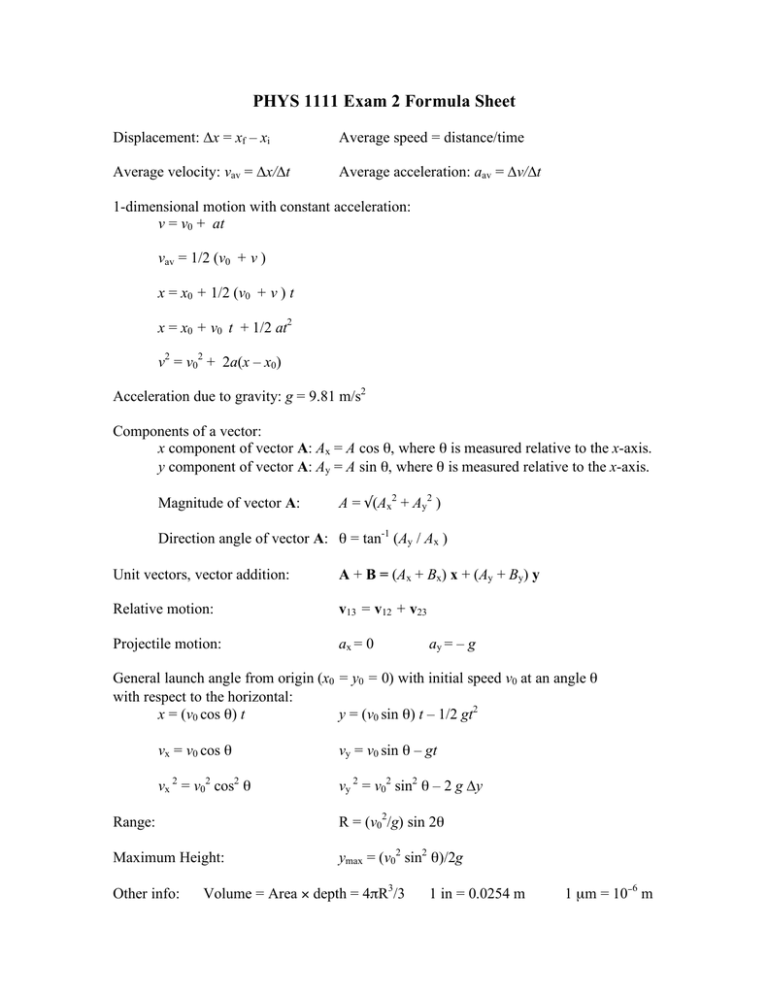
PHYS 1111 Exam 2 Formula Sheet Displacement: ∆x = xf – xi Average speed = distance/time Average velocity: vav = ∆x/∆t Average acceleration: aav = ∆v/∆t 1-dimensional motion with constant acceleration: v = v0 + at vav = 1/2 (v0 + v ) x = x0 + 1/2 (v0 + v ) t x = x0 + v0 t + 1/2 at2 v2 = v02 + 2a(x – x0) Acceleration due to gravity: g = 9.81 m/s2 Components of a vector: x component of vector A: Ax = A cos θ, where θ is measured relative to the x-axis. y component of vector A: Ay = A sin θ, where θ is measured relative to the x-axis. Magnitude of vector A: A = √(Ax2 + Ay2 ) Direction angle of vector A: θ = tan-1 (Ay / Ax ) Unit vectors, vector addition: A + B = (Ax + Bx) x + (Ay + By) y Relative motion: v13 = v12 + v23 Projectile motion: ax = 0 ay = – g General launch angle from origin (x0 = y0 = 0) with initial speed v0 at an angle θ with respect to the horizontal: x = (v0 cos θ) t y = (v0 sin θ) t – 1/2 gt2 vx = v0 cos θ vy = v0 sin θ – gt vx 2 = v02 cos2 θ vy 2 = v02 sin2 θ – 2 g ∆y Range: R = (v02/g) sin 2θ Maximum Height: ymax = (v02 sin2 θ)/2g Other info: Volume = Area × depth = 4πR3/3 1 in = 0.0254 m 1 µm = 10−6 m Newton’s Second Law of Motion (component form): ax = ΣFx/m ay = ΣFy/m az = ΣFz/m (1 N = 1 kg m/s2) Weight: W = mg Kinetic friction: fk = µk N Hooke’s Law: Fx = kx Uniform circular motion: W = Fd cos θ (1 J = 1 N m = 1 kg m2/s2) K = 1/2 mv2 Work-Energy Theorem: Wtotal = ΔK = 1/2 mvf2 – 1/2 mvi2 Work done by a spring: W = 1/2 kx2 Power: fs,max = µs N fcp = macp = mv2/r Work done by a constant force: Kinetic Energy: Static friction: P = W/t = Fv (1 W = 1 J/s = 1 kg m2/s3; 1hp = 746W) Work done by a conservative force: Wc = – ΔU = Ui – Uf Gravitational potential energy: Spring potential energy: U = mgy U = 1/2 kx2 Conservation of mechanical energy: E = U + K Work done by a nonconservative force: Linear momentum: p = mv Newton’s Second Law: Wnc = ΔE = Ef – Ei p total = p 1 + p 2 + p 3 + … Σ F = Δp/Δt Impulse: I = FavΔt = Δp Inelastic collision in one dimension: vf = (m1 v1,i+ m2 v2,i) / (m1 + m2) Elastic collision in one dimension: v1,f = vo (m1 – m2 ) / (m1 + m2) v2,f = 2 m1 vo / (m1 + m2) Location of center of mass: Xcm = (Σ mx)/M Ycm = (Σ my)/M Motion of center of mass: Vcm = (Σ mv)/M Acm = (Σ ma)/M MAcm = Fnet,ext Angular position: θ (in radians) = s / r Average angular velocity: ωav = Δθ/Δt Average angular acceleration: αav = Δω/Δt Period of rotation: T = 2π/ω Rotational kinematic equations: ω = ωo + αt θ = θo + 1/2 (ωo + ω) t θ = θo + ωo t + 1/2 α t2 ω2 = ωo2 + 2 α (θ - θo) Tangential speed: vt = rω Centripetal acceleration: acp = rω2 Tangential acceleration: at = rα Rolling motion: ω=v/r Kinetic energy of a rotating object: K = 1/2 I ω2 Moment of inertia: I = Σ mi ri2 Kinetic energy of rolling motion: K = 1/2 mv2+ 1/2 I ω2 = 1/2 mv2 (1 + I / m r2) Torque for a general force: τ = r F sin θ Newton's second law for rotation: τ = Iα = ΔL/Δt Conditions for static equilibrium: Σ Fx = Σ Fy = Σ τ = 0 Angular momentum: L = Iω = r m v sin θ Work done by a torque: W = τ Δθ Newton's Law of Universal Gravitation: F = G m1 m2 / r2 Acceleration of gravity: g = G ME/ RE2 Kepler's third law: T = (2π/√(GM)) r3/2 Gravitational potential energy: U = – G m1 m2 / r Total mechanical energy: E = K + U = 1/2 mv2 – G m1 m2 / r Escape speed: ve = √(2GM/R) Frequency: f = 1/T Angular frequency: ω = 2πf = 2π/T Position versus time in SHM: x = A cos (2πt/T) = A cos (ωt) Velocity as a function of time in SHM: v = – Aω sin (ωt) Acceleration as a function of time in SHM: a = – Aω2 cos (ωt) Maximum speed of an object in SHM: vmax = Aω Maximum acceleration of an object in SHM: amax = Aω2 Period of a mass on a spring in SHM: T = 2π √(m/k) Total energy of a mass on a spring in SHM: E = 1/2 kA2 Potential energy of a mass on a spring in SHM: U = 1/2 kA2 cos2 (ωt) Kinetic energy of a mass on a spring in SHM: K = 1/2 kA2 sin2 (ωt) Period of a simple pendulum of length L: T = 2π √(L/g)
